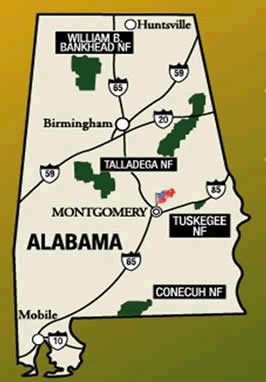Conecuh National Forest
Planning to visit the Conecuh National Forest? Know Before You Go and Plan Your Trip
In case of emergencies and/or road-side assistance, please contact 911.
2024 Recreation Fees and Opening Dates
The Conecuh National Forest is the southern-most national forest in Alabama, encompassing 84,000 acres between Andalusia, Alabama, and the Florida line. This public-land jewel supports prime examples of habitats and associated species found in natural ecosystems of the lower coastal plain. Prime among these habitats are upland longleaf pine forest and shallow ponds and bogs that are maintained by regular ground fires. This rich ecological backdrop provides setting for a wide variety of recreational activities, including hunting, fishing, camping, hiking, backpacking, picnicking, bicycling, shooting sports, wildlife viewing, and nature study. Below is an overview of the activities offered at Conecuh National Forest. You will find additional information in the Recreation Activities section.
Have questions about motorized vehicles in the National Forests in Alabama? Know Before You Go...Travel Tips Q&A
Conecuh National Forest Recreation Map
Map Purchases
On-line
- Available for purchase online at the U.S. Geological Survey Store.
- For those using the Avenza app, many Forest Visitor Maps are also available for purchase as georeferenced PDFs on Avenza, for use on mobile devices.
Maps on the Go!
- Need a Mobile Map? Get the Alabama Great Escapes App! Keyword - National Forests in Alabama. Category - Parks, Forests and Grasslands
Free Downloadable Maps
The following maps are downloadable free of charge.
- Bankhead National Forest Recreation Map
- Conecuh National Forest Recreation Map
- Talladega National Forest - Cheaha Wilderness Area Map
- Talladega National Forest - Oakmulgee District Recreation Map
- Talladega National Forest - Shoal Creek District Recreation Map
- Talladega National Forest - Talladega District Recreation Map
- Tuskegee National Forest Trail Map
- Owl Creek Non-motorized Trail Map Flint Creek Multiple Use Trail Map
- Sipsey Wilderness Map
Hunting
Hunting of deer, turkey, quail , and other small game is one of the most popular recreational activities on the Conecuh. The Conecuh National Forest is open to the public for hunting under Alabama state hunting regulations. Blue Spring Wildlife Management Area, located on the Conecuh National Forest, is also open for public hunting under special rules. For detailed information on hunting on the Conecuh National Forest and Blue Spring Wildlife Management Area, please visit the official website of Alabama Department of Conservation and Natural Resources.
Campgrounds
Scenic views, well-maintained facilities, and a diversity of recreational opportunities await you at Open Pond Recreation area. The campground at Open Pond includes primitive sites as well as those with water and electric hook-ups, with easy access to boating, fishing, hiking, and bicycle riding. Open Pond Recreation Area also includes a day-use area designed for peaceful picnicking with a panoramic view of Open Pond. A group shelter here was built in the 1930's by the Civilian Conservation Corps (CCC). It retains its original distinct design and is interesting to those who enjoy CCC history.
Hiking
The Conecuh Trail winds 20 miles through the eastern portion of the Conecuh National Forest. The trail was built by the Youth Conservation Corps. Each year beginning in 1976, the young people of the Corps extended the trail through park-like longleaf pine forests, around sinkhole ponds, and across streams and bottomlands. The trail showcases the diversity of Conecuh ecosystems for the day hiker and backpacker.
The south loop of the Conecuh Trail leads to Blue Springs, a large natural spring of clear, icy blue water. The Conecuh Trail crosses streams at several points. Bridges have been built for the convenience of trail hikers.
The Conecuh Trail is open year round, but winter hiking is most pleasant when the weather is cooler and insects not so bothersome. Summers can be hot and humid. From mid-November through the end of January, hikers and backpackers should coordinate trips with the District Office to ensure compatibility with scheduled deer hunts on Blue Spring Wildlife Management Area.
History of The Conecuh National Forest
On January 21, 1935, the National Forest Reservation Commission established the Conecuh Purchase Unit in Covington and Escambia Counties.
The Conecuh National Forest was created by presidential proclamation on July 17, 1936. Located in Covington and Escambia Counties, the Conecuh National Forest originally contained 54,117 acres of cutover and burned-over lands. At the time of acquisition, most of the lands were barren of timber except for scattered trees that had been too small for logging operators. Initially, the first task at hand was to control wild fires. Once the wild fires were controlled, natural reproduction of the native pine species were able to restock much of the area. The Civilian Conservation Corps enrollees planted thousands of acres of tree seedlings from 1936 to 1942 in areas where natural regeneration was not successful. The reforestation of the Conecuh National Forest was a slow process due to the many years of misuse prior to acquisition. In 1941 the Conecuh National Forest produced only 74 thousand board feet of timber. In the fall of 1947, prescribe burning was used extensively for the first time to assist in bringing back the pine forest. As the young plantations were established, it was necessary to provide protection from hogs and cattle. Approximately 130 miles of hog-proof fencing had been constructed by 1949. By June 30, 1949, the Conecuh National Forest had increased to 83,866 acres through land acquisition. Timber production was only 113 thousand board feet of timber being cut in 1950.
In the last 50 years, the Conecuh National Forest has gone through many changes, and yet, in many ways, stays the same. Today, the forest contains just over 84,000 acres. The mid-1980s saw the peak of timber production for the forest. Hurricane Opal hit in October of 1995. The resulting clean up and salvage operations were the focus for the following year. In the 21st Century, the forest priorities are the restoration of the Long Leaf Pine ecosystem, enhancement of the habitat for the Red-Cockaded woodpecker, and the restoration of the recreation areas.
The Civilian Conservation Corps
The Civilian Conservation Corps (CCC) was created in the first weeks of President Franklin D. Roosevelt’s administration in 1933. Recognizing that the loss of natural resources and the terribly high unemployment were two of the greatest threats to the nation, President Roosevelt asked Congress to pass the Emergency Conservation Works Act. The act created the Civilian Conservation Corps, and by the summer of 1933, 250,000 young men and World War One veterans were replanting forests and working on soil erosion prevention projects.
Robert Fechner, a friend of President Roosevelt and a labor leader, headed the Civilian Conservation Corps. An Advisory Council was created, consisting of representative of the Departments of War, Labor, Agriculture and Interior.
The selection for enrollment for the Junior Enrollees, initially between the ages of 18 and 25, later between 17 and 23, was conducted by the County Welfare Departments of the Department of Labor. The Department of War, the Army, was responsible for the running of the CCC Camps. The work projects were supervised by agencies of the Department of Agriculture and Interior. Each enrollee selected for the CCC agreed to send $25 of his $30 monthly pay home to a dependent. In this manner, not only were jobs created for the unemployed young men, but also their families were supported. In Alabama, over 66,000 men were enrolled in the CCC between 1933 and 1942. Total obligations in Alabama amounted to over $55,000,000. Over $16,000,000 was sent home to dependents by enrollees.
On February 4, 1936, Company 3474 of the Civilian Conservation Corps established CCC Camp F-9 at Open Pond on the Conecuh National Forest. The company consisted of “Junior” African-Americans between the ages of 18 and 25. From 1935 to 1942, the enrollees of Company 3474 built roads across the forest to improve access for fire protection and management, constructed fire towers, replanted thousands of acres of the forest, fought forest fires, and constructed a recreational area at Open Pond.
The Open Pond Fire Tower
The Open Pond Fire Tower was the first of four fire towers constructed by the Civilian Conservation Corps Company 3474 on the Conecuh National Forest between 1937 and 1939. The Open Pond Fire Tower, along with towers at Parker Springs, Dixie, and Yellow River, provided visual coverage of the Conecuh National Forest. By sighting a smoke column from any two of the four towers, the location of the fire could be accurately assessed. Telephone lines connected the four towers with the Forest Service office and the CCC Camp at Open Pond, which was located less than a half-mile to the southeast of the tower. The telephone communications assured the quickest response time possible in taking action against the greatest threat to the forest – forest fire.
The twelve-foot by twelve-foot cabin on top of the 100-foot steel tower was equipped to allow the lookout to remain in the tower at their post for 24 hours a day during the high fire risk season. Each tower cabin was equipped with a map table; a map board and map; range-finding apparatus; a telephone; a stool or chair; amber glasses; a case containing the necessary forms, notebooks, and pencils; weather observing apparatus; organization chart and written instructions; a telephone directory; a copy of the fire handbook; a portable phone; and a telephone trouble book. A folding table and a fold-down cot was installed in the cabin. The table and cot would be lowered as needed, maximizing the space available in the twelve-foot by twelve-foot cabin.
Through the years, the fire tower at Yellow River and at Dixie were dismantled and removed. The Parker Springs Fire Tower was modified in 1968. The Open Pond Fire Tower remains as it was constructed in 1937. In January of 1995, the Open Pond Fire Tower was listed by the National Historic Lookout Register. It was the 97th fire tower listed in the nation, and the first tower registered in the State of Alabama. In 1999, in consultation with the Alabama Historic Commission, the Open Pond Fire Tower was determined to be eligible for the National Register of Historic Places.
Open Pond Recreation Area
Open Pond is one of many sinkhole ponds common in the limestone topography of southern Alabama and Florida. The pure waters of the pond were used as the drinking supply of the Civilian Conservation Corps Camp F-9 at Open Pond in February of 1936 until a deep well was dug in March of 1937.
As the Civilian Conservation Corps made their many improvements on the Conecuh National Forest, plans were made for development of a recreational area at Open Pond in 1937. By June of 1938, a beautiful log-cabin bathhouse has been constructed on the eastern shore of the pond. The bathhouse measured 65 feet by 48 feet, with a roof of hand-riven cypress shingles, and contained dressing rooms and shower rooms. A combination basket and concession room in the middle of the bathhouse had enough space for 440 baskets. Construction was underway on a picnic shelter, measuring 17 feet by 40 feet with a five by six-foot fireplace. Seventeen combination table and seats were constructed in the picnic area with twelve open-air fireplaces. A bathing area with a 500-foot white sandy beach was also constructed. Ropes and markers delineated a children’s wading area and the five-foot depth for adults. A parking area was constructed with enough space for 75 cars. There was over a mile of trails constructed throughout the recreational area. The trails were surfaced with a combination of sandy clay, sawdust and salt. A hitching rack for horses and mules was planned to be constructed.
The Open Pond Recreation Area was immediately one of the most popular recreational spots in the area. The Andalusia Star reported that the Andalusia Lions Club met there in October of 1939. The Army held maneuvers at Open Pond in November of 1939. The Boy’s 4-H Annual Camp was held at Open Pond in the summer of 1941. The 1957 Recreation Plan for the Alabama National Forests considered the Open Pond Recreation Area as one of the outstanding recreation spots on the forest. The plan called for expansion of the recreation area to include additional facilities for camping and the paving of a boat landing. In the early 1960s, plans were made to add camping facilities along the northwestern and southern sides of Open Pond. The Conecuh National Forest removed the bathhouse sometime in the mid-1960s.
During the summer of 2001, the CCC Picnic Shelter at Open Pond was reconstructed. The original 1938 structure had deteriorated from the attacks of termites and weather. The people from the local area let the Conecuh National Forest know that they wanted the Old CCC Shelter reconstructed rather than building a modern picnic shelter. Plans are being made at the present time to upgrade and rehabilitate the camping facilities at the Open Pond Recreation Area.
Robert G. Pasquill, Jr.
National Forests in Alabama
Forest Archeologist and Historian (Deceased)





